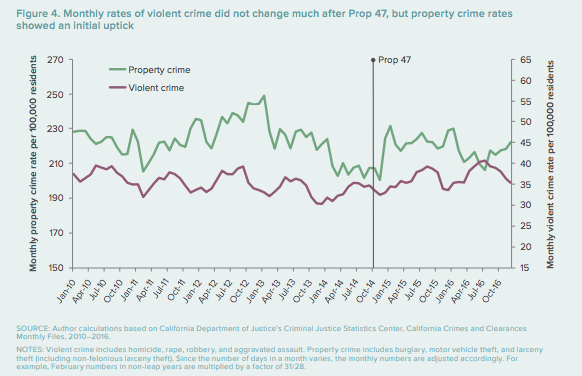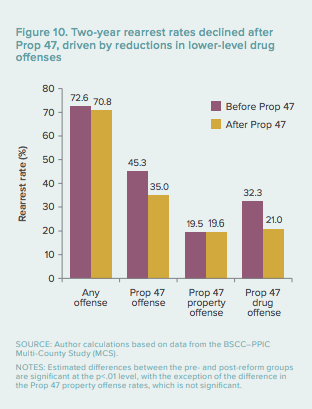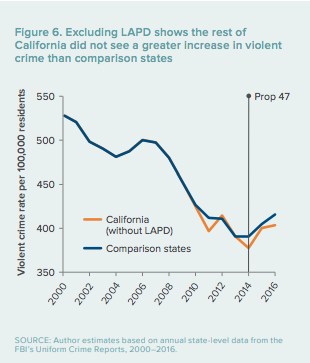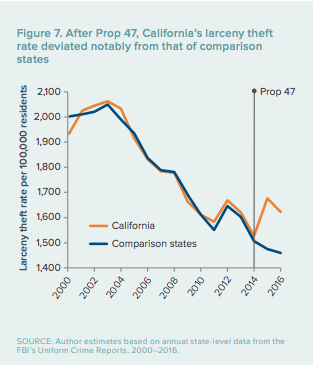While California crime rates remain at historic lows, voter-approved Proposition 47 appears to have led to an increase in certain property crimes, according to a new Public Policy Institute of California report that aims to shed some light on the effects of the measure–an ongoing, contentious point of debate in the state.
While researchers found what appeared to be a correlation between Prop. 47 and upticks in larceny, the measure did not make a measurable contribution to the state’s increase in violent crime. Moreover, Prop. 47 appears to have contributed to a reduction in recidivism in California, while also lowering the prison and jail populations.
Background on the Sentencing Reform Measure
Passed in 2014, Prop. 47 downgraded six low-level property and drug-related felonies to misdemeanors, and thus, reduced the state’s prison population. (Prop. 47 offenses are check forgery worth $950 or less, theft of property worth $950 or less, writing bad checks worth $950 or less, receiving stolen property worth $950 or less, shoplifting property worth $950 or less, and drug possession.)
“When voters overwhelmingly approved Proposition 47, it was urgent that California address bloated and costly prisons and invest taxpayer money more effectively to stop the cycle of crime,” said Lenore Anderson, founder of Californians for Safety and Justice, and co-author of Prop. 47.
Money saved by Prop. 47 was earmarked for mental health services and drug rehab programs for criminal justice system-involved people, efforts to reduce truancy and help at-risk students, and for victims services.
In June 2017, the state portioned out chunks of the $103 million in savings to 23 California cities and counties to spend on community programs focused on reducing recidivism.
“While it is too early to know if this shift in funding has affected recidivism rates,” the report said, “in the coming years the state and counties will be better able to assess the impact of increased interventions and to identify promising strategies.”
What the Data Indicates
Researchers found that recidivism rates for the affected crimes did drop after the passage of Prop. 47, but pinpointing why the numbers dropped is complicated.
Sampling data from 12 counties, researchers calculated that all crime offenders were rearrested at a rate of 70.8 percent—1.8 percent lower than for their peers released prior to Prop. 47’s implementation.
The two-year rearrest rate for people convicted of Prop. 47 crimes, however, dropped from 45.3 percent before Prop. 47, to 35 percent after the measure was passed.
The drop in rearrests for all crimes was primarily due to a reduction in “rearrests for Prop 47 drug offenses,” the report stated.
After Prop. 47, drug offense rearrests dropped 11.3 percent, while rearrest rates for property crimes remained largely unchanged.
Researchers believe that this contrast is due to reduced enforcement of Prop. 47 offenses, because “law enforcement has more flexibility in responding to drug offenses than property offenses.”
The numbers also dropped for reconviction rates as well as rearrests.
The post-Prop. 47 two-year reconviction rate for all crimes was 46 percent—3.1 percent lower than before Prop. 47’s sentencing changes.
When researchers narrowed the data down to Prop. 47 offenses, the two-year reconviction rates dropped even further—from 25.4 to 14.1 percent.
The differences may be due to less street-level enforcement by law enforcement officers, according to the report, as well as “changes in underlying offender behavior.” The report also suggested that “lower charging rates among district attorneys and/or less willingness to accept plea deals among public defenders,” may factor into the reconviction rate disparity.
Fewer People Behind Bars
In 2015, the first year that Prop. 47’s sentencing reductions were in effect, prison and jail populations also dropped significantly. PPIC attributes much of the drop to Prop. 47, although other federal court-ordered prison population reduction strategies played a role.
The state’s prison population declined by 8,100 inmates (6 percent) in 2015. The California Legislative Analyst’s Office estimated that Prop. 47 was responsible for 4,700 of 8,100-person drop.
Additionally, there were approximately 7,000 fewer inmates in county jails in 2015.
The data shows that officers arrested fewer people overall after Prop. 47, but also conducted more “cite and releases,” in which a person is arrested, given a citation, and then released, rather than taken to jail.
“The average monthly number of arrests dropped from 124,400 in the year before Prop 47 (from November 2013 to October 2014) to 118,500 in the year after (from November 2014 to October 2015), a decline of about 5 percent,” the report said. At the same time cite and releases increased from 30,300 to 32,800, and accounted for 14 percent more of the total number of arrests than in the previous year.
Complex Crime Trends and Prop. 47
Researchers also looked at the Prop. 47’s impact on California’s crime rates, which, the report points out, remained at historic lows between 2014 and 2016.
According to the report, Prop. 47 was not a factor in the state’s violent crime rates, which increased 13 percent between 2014 and 2016. “This trend appears to have preceded the reform,” the researchers said.
PPIC attributes much of the spike in violent crime to “unrelated changes in crime reporting after 2014.”
In 2014, the FBI expanded the list of crimes that constitute rape, increasing the reported rapes by 38 percent, and the violent crime rate from what would have been a 10.7 percent increase, to a 13 percent increase over the previous year.
Additionally, an investigation by the LA Times’ Joel Rubin and Ben Poston found that the LAPD mislabeled close to 1,200 violent crimes as minor offenses, significantly altering the city’s crime statistics. The reporters found that “with the incidents counted correctly, violent crime in the city was 7 percent higher than the LAPD reported in the period from 2005 to fall 2012, and the number of serious assaults was 16 percent higher.”
After the story broke, the LAPD announced that it would implement crime reporting reforms.
LA’s Inspector General audited the department’s crime stats in 2015, and found that the aggravated assault rates between 2008 and 2014 would have been approximately 36 percent higher each year, had the department properly classified the crimes.
“The statewide increase in the violent crime rate between 2014 and 2016 was 13 percent,” the report said. “This drops to 6.4 percent when Los Angeles is excluded. When we account for both the definitional change in rape and exclude Los Angeles, the increase drops to 4.7 percent. With these two adjustments, the violent crime rate in 2016 is lower than it was in all other years since 2010, with the exception of 2014.”
PPIC looked at California’s violent crime rates without Los Angeles, and found that it was comparable to—even slightly lower than—other comparison states’ violent crime spikes during those years.
The Connection Between Prop. 47 and Larceny
PPIC’s research did find a connection between the state’s increase in larceny crimes and Prop. 47, however.
Auto theft rates and burglaries, both attributed by critics to Prop. 47 were comparable to other states, the researchers found. But the increase in larceny rates when compared to other states was “marginally statistically significant,” according to the report. “We estimate that Prop 47 led to a rise in the larceny theft rate of about 135 per 100,000 residents, an increase of close to 9 percent compared to the 2014 rate,” researchers said.
Anderson, founder of Californians for Safety and Justice, said reduced recidivism and prison and jail populations, in combination with historically low crime rates and reinvestment in anti-recidivism programs, shows that Prop. 47 is helping to “rebalance” the state’s investments in public safety.
“Despite this progress, we still have a long way to go,” Anderson said. “California still spends more than $11 billion a year on state prisons – more than the general fund budgets of the University of California and California State University systems combined. And many local safety strategies still lack adequate support and need to be expanded, such as diversion, crisis response and housing.”
It’s time, said Anderson, to take rebalancing spending on the criminal justice system “to the next level.”





I hope this doesn’t really come as a shock to our learned politicians and all the astute and learned academic social scientist. “Hello McFly…..are you in there…”
Why of course, by de-criminalizing the nexus to criminal drug activity, which is usually theft and property crime since these “solid citizen victims” can’t hold a job, the commission of these crimes will go up. If you make law enforcement the boogie man, minimize penalties and societal views on drug offenses, they won’t enforce these laws. The will use all the discretion in the world. It’s simply not worth the risks to their careers and livelihood when judged harshly by not only their respective departments, but the court of public opinion.
The state wanted to save money by emptying the prisons and pushing the costs and responsibility onto the counters. While opportunistic progressive politicians and activist latched on to advance their anti-law enforcement agenda. Now here we are.
Of course, not surprising to the folks who are on the front-line and have the “real-life” practical experience with criminals and their behaviors. No front-line police officers (I don’t mean clueless executive types either) were ever even consulted or asked their opinion.
Governor Brown …keep on building and spending on that $70++ BILLION train to nowhere nobody wants though. Not enough money for roads, prisons and mental health hospitals though….yeah right.
Witness la, instead of trying to gaslight the public into believing that prop. 47 is such a great deal, how about following up on LAPD underreporting violent crime to the tune of 36 percent per year? Prop 47 was voted in ,so the public pretty much deserves what they get in that regard, so who cares? That LAPD thing sounds pretty awful. Who ordered that? Is the mayor involved? How about the new chief, was he involved? It’s going to require a little more effort than cutting and pasting some bs report from “Californians for safety and justice” but you may actually get to do some real journalism.
Don’t shoot the piano player.
Speaking of shoot, 30 officers gunned down this year so far. The 30th last year was on August 18th. It’s disgraceful Celeste your silence on this issue and you know why. Nothing but pretense that you or anyone on your staff cares one bit about cops, never have and never will.